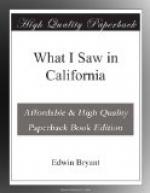October 25.—Continuing our voyage, we landed, about nine o’clock, A.M., at an Indian rancheria, situated on the bank of the river. An old Indian, his wife, and two or three children, were all the present occupants of this rancheria. The woman was the most miserable and emaciated object I ever beheld. She was probably a victim of the “sweat-house.” Surrounding the rancheria were two or three acres of ground, planted with maize, beans, and melons. Purchasing a quantity of water and musk-melons, we re-embarked and pursued our voyage. As we ascended the stream, the banks became more elevated, the country on both sides opening into vast savannas, dotted occasionally with parks of evergreen oak.
The tide turning against us again about eleven or twelve o’clock, we landed at an encampment of Walla-Walla Indians, a portion of the party previously referred to, and reported to have visited California for hostile purposes. Among them was a Delaware Indian, known as “Delaware Tom,” who speaks English as fluently as any Anglo-Saxon, and is a most gallant and honourable Indian. Several of the party, a majority of whom were women and children, were sick with chills and fever. The men were engaged in hunting and jerking deer and elk meat. Throwing our hooks, baited with fresh meat, into the river, we soon drew out small fish enough for dinner.
The specimens of Walla-Wallas at this encampment are far superior to the Indians of California in features, figure, and intelligence. Their complexion is much lighter, and their features more regular, expressive, and pleasing. Men and women were clothed in dressed skins. The men were armed with rifles.
At sunset we put our little craft in motion again, and at one o’clock at night landed near the cabin of a German emigrant named Schwartz, six miles below the embarcadero of New Helvetia. The cabin is about twenty feet in length by twelve in breadth, constructed of a light rude frame, shingled with tule. After gaining admission, we found a fire blazing in the centre of the dwelling on the earth-floor, and suspended over us were as many salmon, taken from the Sacramento, as could be placed in position to imbibe the preservative qualities of the smoke.
Our host, Mr. Schwartz, is one of those eccentric human phenomena rarely met with, who, wandering from their own nation into foreign countries, forget their own language without acquiring any other. He speaks a tongue (language it cannot be called) peculiar to himself, and scarcely intelligible. It is a mixture, in about equal parts, of German, English, French, Spanish, and rancheria Indian, a compounded polyglot or lingual pi—each syllable of a word sometimes being derived from a different language. Stretching ourselves on the benches surrounding the fire, so as to avoid the drippings from the pendent salmon, we slept until morning.
October 26.—Mr. Schwartz provided us with a breakfast of fried salmon and some fresh milk. Coffee, sugar, and bread we brought with us, so that we enjoyed a luxurious repast.




